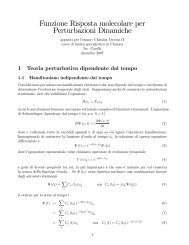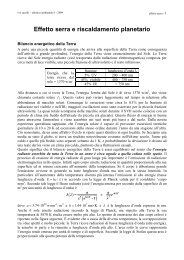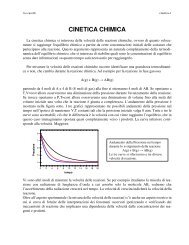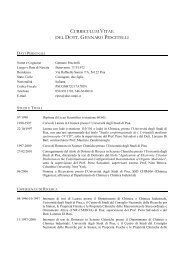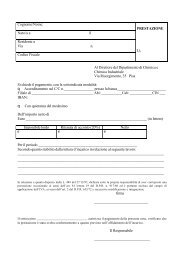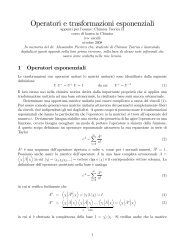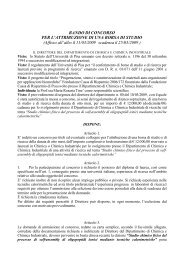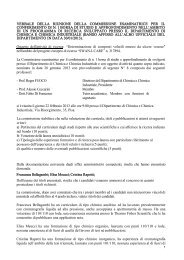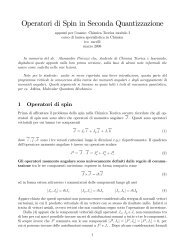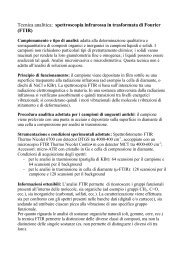Appunti del corso di Chimica Fisica II - Dipartimento di Chimica e ...
Appunti del corso di Chimica Fisica II - Dipartimento di Chimica e ...
Appunti del corso di Chimica Fisica II - Dipartimento di Chimica e ...
- No tags were found...
Create successful ePaper yourself
Turn your PDF publications into a flip-book with our unique Google optimized e-Paper software.
L’equazione <strong>di</strong> Schroe<strong>di</strong>nger si può così scrivere:( {− 2 ∂22µ ∂r 2 + 2 )∂− L 2 }(θ, φ)r ∂r 2µr 2 + V (r) Ψ(r, θ, φ) = EΨ(r, θ, φ)Moltiplicando ambo i membri per 2µr 2 :( ∂{ 2 r 2 2∂r 2 + 2 ) }∂+ 2µr 2 V (r) − L 2 Ψ(r, θ, φ) = 2µr 2 EΨ(r, θ, φ)r ∂rRiarrangiando:{ 2 r 2 ( ∂2∂r 2 + 2 r)}∂+ 2µr 2 V (r) − 2µr 2 E Ψ(r, θ, φ) = L 2 Ψ(r, θ, φ)∂rSi nota che il membro <strong>di</strong> destra <strong>di</strong>pende solo da r, mentre quello <strong>di</strong> sinistra <strong>di</strong>pendesolo dalle variabili angolari; viene quin<strong>di</strong> naturale fattorizzare la funzioned’onda in una parte ra<strong>di</strong>ale ed una angolare:Ψ(r, θ, φ) = R(r)Y (θ, φ)Sostituendo:Y (θ, φ)r 2 { 2 ( ∂2∂r 2 + 2 r<strong>di</strong>videndo ambo i membri per R(r)Y (θ, φ):r 2 ( ∂{ 2 2R(r) ∂r 2 + 2 ∂r ∂r)}∂+ 2µV (r) − 2µE R(r) = R(r)L 2 Y (θ, φ)∂r)+ 2µV (r) − 2µE}R(r) =1Y (θ, φ) L 2 Y (θ, φ)Affinché l’equazione abbia soluzioni entrambi i membri devono essere uguali aduna costante a: <strong>di</strong>videndo nuovamente l’equazione ra<strong>di</strong>ale per 2µr 2 si ottiene:⎧⎪⎨ L 2 (θ, φ)Y (θ, φ) = aY (θ, φ)⎪⎩{− 22µ(∂ 2∂r 2+ 2 r)}∂∂r+ V (r) − a2µrR(r) = ER(r)2Equazione angolare Nell’affrontare la soluzione <strong>del</strong>l’equazione angolare ènecessario <strong>di</strong>scutere alcune importanti proprietà <strong>di</strong> commutazione <strong>del</strong>l’operatoremomento angolare e <strong>del</strong>le sue componenti. Ovviamente L 2 commuta conl’hamiltoniano, inoltre:[L 2 , L x ] = [L 2 x , L x ] + [L 2 y , L x ] + [L 2z , L x ][L 2 x , L x ] = 0[L 2 y , L x ] = L y L y L x − L x L y L y = L y ([L y , L x ] + L x L y )−− ([L x , L y ] + L y L x )L y = −iL y L z − iL z L y[L 2z , L x ] = L z L z L x − L x L z L z = L z ([L z , L x ] + L x L z )−− ([L x , L z ] + L z L x )L z = iL z L y + iL y L z36



